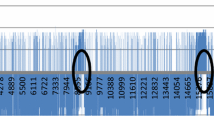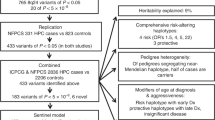Abstract
Multiple endocrine neoplasia type 1 (MEN1) is an autosomal dominant disorder that predisposes affected individuals to neoplasms of the parathyroid glands, endocrine pancreas, anterior pituitary, and carcinoids. The MEN1 locus has been localized by family studies to 11q13, flanked by markers PGA and D11S97. Eight new polymorphisms located in three separate radiation-reduced somatic cell hybrid segregation groups were developed. The order of the new markers, within the context of previously described loci, was determined by linkage analysis on the Venezuelan reference pedigree. Four independent MEN1 families, consisting of 57 affected individuals, and 70 individuals at-risk for the disease were genotyped. Sixteen people inherited a chromosome that shows recombination between a linked marker and the disease. The nearest proximal and distal markers that show recombination with the disease are D11S822 and GSTP1, respectively, thereby narrowing the candidate region for MEN1 by 50% on the distal side. Using these loci in haplotype analysis, an accurate presymptomatic molecular diagnostic test has been developed. These new markers in 11q13 linked to MEN1 also facilitate the genetic and physical characterization of this very gene-rich region.
Similar content being viewed by others
References
Bale AE, Norton JA, Wong EL, Fryburg JS, Maton PN, Oldfield EH, Streeten E, Aurbach GD, Brandi ML, Friedman E, Spiegel AM, Taggart RT, Marx SJ (1991) Allelic loss on chromosome 11 in hereditary and sporadic tumors related to familial multiple endocrine neoplasia type 1. Cancer Res 51:1154–1157
Bale SJ, Bale AE, Stewart K, Dachowski L. McBride OW, Glaser T, Green JE, Mulvihill JJ, Brandi M, Sakaguchi K, et al (1989) Linkage analysis of multiple endocrine neoplasia type 1 with INT2 and other markers on chromosome 11. Genomics 4:320–322
Botstein D, White RL, Skolnick M, Davis RW (1980) Construction of a genetic linkage map in man using restriction fragment length polymorphisms. Am J Hum Genet 32:314–331
Brandi ML, Weber G, Svensson A, Falchett A, Tonelli F, Catello R, Furlani L, Scappaticci S, Fraccaro M, Larsson C (1993) Homozygotes for the autosomal dominant neoplasia syndrome (MEN1). Am J Hum Genet 53:1167–1172
Browne DL, Gault J, Thompson MB, Hauge XY, Evans GA, Litt M (1991) Dinucleotide repeat polymorphism at the D11S527 locus. Nucleic Acids Res 19:4790
Bystrom C, Larsson C, Blomberg C, Sandelin K, Falkmer U, Skogseid B, Oberg K, Werner S, Nordenskjold M (1990) Localization of the MEN1 gene to a small region within chromosome 11q13 by deletion mapping in tumors. Proc Natl Acad Sci USA 87:1968–1972
Call KM, Glaser T, Ito CY, Bucker AJ, Pelletier J, Haber DA, Rose EA, Kral A, Yeger H, Lewis WH, Jones C, Housman DE (1990) Isolation and characterization of a zinc finger polypeptide gene at the human chromosome 11 Wilms' tumor locus. Cell 60:509–520
Casey G, Smith R, McGillivray D, Peters G, Dickson C (1986) Characterization and chromosome assignment of the human homolog of int-2, a potential proto-oncogene. Mol Cell Biol 6:502–510
Cooperative Human Linkage Center, (CHLC): Murray JC et al (1994) A comprehensive human linkage map with centimorgan density. Science 265:2049–2054
Cutler RE, Reiss E, Ackermann LA (1964) Familial hyperparathyroidism: a kindred involving eleven cases with a discussion of primary chief-cell hyperplasia. N Engl J Med 270:859–865
Feinberg AP, Vogelstein B (1983) A technique for radiolabelling DNA restriction endonuclease fragments to high specific activity. Anal Biochem 132:6–13
Finlay CA, Hinds PW, Levine AJ (1989) The p53 proto-oncogene can act as a suppressor of transformation. Cell 57:1083–1093
Forsman K, Graff C, Nordstrom S, Johansson K, Westermark E, Lundgren E, Gustavson K-H, Wadelius C, Holmgren G (1992) The gene for Best's macular dystrophy is located at 11q13 in a Swedish family. Clin Genet 42:156–159
Foroud T, Wei S, Ziv Y, Sobel E, Lange E, Chao A, Goradia T, Huo Y et al (1991) Localization of an ataxia-telangiectasia locus to a 3-cM interval on chromosome 11q23: linkage analysis of 111 families by an international consortium. Am J Hum Genet 49:1263–1279
Friend SH, Bernards R, Rogelj S, Weinberg RA, Rapaport JM, Albert DM, Dryja TP (1986) A human DNA segment with properties of the gene that predisposes to retinoblastoma and osteosarcoma. Nature 323:543–636
Fujimori M, Wells SA Jr, Nakamura Y (1992) Fine-scale mapping of the gene responsible for multiple endocrine neoplasia type 1 (MEN1). Am J Hum Genet 50:399–403
Gerhard DS, Lawrence E, Wu J, Chua H, Ma N, Bland S, Jones C (1992) Isolation of 1001 new markers from human chromosome 11, excluding the region of 11p13–p15. 5, and their sublocalization by a new series of radiation-reduced somatic cell hybrids. Genomics 13:1133–1142
Goldsmith RE, Sizemore GW, Chen I-W, Zalme E, Altemeier A (1976) Familial hyperparathyroidism: description of a large kindred with physiologic observations and a review of the literature. Ann Intern Med 84:36–43
Gyapay G, Morisette J, Vignal A, Dib C et al (1994) The 1993–94 Genethon human linkage map. Nat Genet 7 [Suppl]:246–339
Haines JL, Trofatter JA, Tanzi RE, Watkins P, Wexler NS, Conneally PM, Gusella JF (1992) Chromosome 21 genetic linkage data set based on the Venezuelan reference pedigree. Cytogenet Cell Genet 59:88–89
Iwasaki H, Stewart PW, Dilley WG, Holt MS, Steinbrueck TD, Wells SA, Donis-Keller H (1992) A minisatellite and a microsatellite polymorphism within 1. 5 kb at the human muscle glycogen phosphorylase (PYGM) locus can be amplified by PCR and have combined informativeness of PIC 0. 95. Genomics 13:7–15
Janson M, Larsson C, Werelius B, Jones C, Glaser T, Nakamura Y, Jones CP, Nordenskjold M (1991) Detailed physical map of human chromosomal region 11q12–13 shows high meiotic recombination rate around the MEN 1 locus. Proc Natl Acad Sci USA 88:10609–10613
Julier C, Nakamura Y, Lathrop M, O'Connell P, Lepper M, Litt M, Mohandas T, Lalouel J, White R (1990) A detailed genetic map of the long arm of chromosome 11. Genomics 7:335–345
Kamb A, Gruis NA, Weaver-Feldhaus J, Liu Q, Harshman K, Tavtigian SV, Stocker E, Day KH III, Johnson BE, Skolnick MH (1994) A cell cycle regulator potentially involved in genesis of many tumor types. Science 264:436–440
Knudson AG (1971) Mutation and cancer: statistical study of retinoblastoma. Proc Natl Acad Sci USA 68:820–823
Lander ES, Green P (1987) Construction of multilocus genetic linkage maps in humans. Proc Natl Acad Sci USA 84:2363–2367
Larsson C, Skogseid B, Oberg K, Nakamura Y, Nordenskjold M (1988) Multiple endocrine neoplasia type 1 gene maps to chromosome 11 and is lost in insulinoma. Nature 332:85–87
Larsson C, Weber G, Kvanta E, Lewis K, Janson M, Jones C, Glaser T, Evans G, Nordenskjold M (1992a) Isolation and mapping of polymorphic cosmid clones used for sublocalization of the multiple endocrine neoplasia type 1 (MEN1) locus. Hum Genet 89:187–193
Larsson C, Shepherd J, Nakamura Y, Blomber C, Weber G, Werelius B, Hayward N, Teh B, Tokino T, Seizinger B, Skogseid B, Oberg K, Nordenskjold M (1992b) Predictive testing for multiple endocrine neoplasia type 1 using DNA polymorphisms. J Clin Invest 89:1344–1349
Lathrop GM, Lalouel JM, Julier C, Ott J (1984) Strategies for multilocus linkage analysis in humans. Proc Natl Acad Sci USA 81:3443–3446
Leppert M, Baird L, Anderson K, Otterud B, Lupski JR, Lewis RA (1994) Bardet-Biedl syndrome is linked to DNA markers on chromosome 11q and is genetically heterogeneous. Nat Genet 7:108–112
Li Y, Muller B, Fuhrman C, Nouhuys EC van, Laqua H, Humphries P, Scwinger E, Gal A (1992) The autosomal dominant familial exudative vitreoretinopathy locus maps on 11q and is closely linked to D11S533. Am J Hum Genet 51:749–754
Litt M, Kramer P, Hauge XY, Weber JL, Wang Z, Wilkie PJ, Holt MS, Mishra S, Donis-Keller H, Warnich L, Retief AE, Jones C, Weissenbach J (1993) A microsatellite-based index map of human chromosome 11. Hum Mol Genet 2:909–913
Maslen C, Jones C, Glaser T, Sheehy R, Magenis RE, Kellogg J, Litt M (1987) Seven polymorphic loci mapping to human chromosomal region 11q22-qter. Cytogenet Cell Genet 46:656
Moffatt MF (1993) Dinucleotide repeat polymorphism at the D11S480 locus. Hum Mol Genet 2:492
Murray JC, Buetow KH, Weber JL, Ludigsen S, Scherpbier-Heddema T, Manion F, Quillen J, Sheffield VC, Sunden S, Duyk GM (1994) A comprehensive human linkage map with centimorgan density. Science 265:2049–2054
Nakamura Y, Larsson C, Julier C, Bystrom C, Skogseid B, Wells S, Oberg K, Carlson M, Taggart T, O'Connell P, Leppert M, Lalouel J-M, Nordenskjold M, White R (1989) Localization of the genetic defect in multiple endocrine neoplasia type 1 within a small region of chromosome 11. Am J Hum Genet 44:751–755
Nobori T, Miura K, Wu DJ, Lois A, Takabayash K, Carson DA (1994) Deletions of the cyclin-dependent kinase-4 inhibitor gene in multiple human cancers. Nature 368:753–756
Polymeropoulos MH, Xiao H, Rath DS, Merril CR (1991) Dinucleotide repeat polymorphism at the int-2 proto-oncogene locus (INT2). Nucleic Acids Res 18:1468
Radford DM, Ashley SW, Wells SA Jr, Gerhard DS (1990) Loss of heterozygosity of markers on chromosome 11 in tumors from patients with multiple endocrine neoplasia syndrome type 1. Cancer Res 50:6529–6533
Smith CM, Bora PS, Bora NS, Jones C, Gerhard DS (1995) Genetic and radiation-reduced somatic cell hybrid sublocalization of the human GSTP1 gene. Cytogen Cell Genet (in press)
Stafford AN, Rider SH, Hopkin JM, Cookson WO, Monaco AP (1994) A 2. 8 Mb YAC contig in 11q12–q13 localizes candidate genes for atopy: FceRIβ and CD20. Hum Mol Genet 3:779–785
Stone EM, Nichols BE, Streb LM, Kumura AE, Sheffield VC (1992 a) Genetic linkage of vitelliform macular degeneration (Best's disease) to chromosome 11q13. Nat Genet 1:246–250
Stone EM, Kimura AE, Folk JC, Bennett SR, Nichols BE, Streb LM, Sheffield VC (1992b) Genetic linkage of autosomal dominant neovascular inflammatory vitreoretinopathy to chromosome 11q13. Hum Mol Genet 1:685–689
Taggart RT, Mohandas TK, Shows TB, Bell GI (1985) Variable numbers of pepsinogen genes are located in the centromeric region of human chromosome 11 and determine the high-frequency electrophoretic polymorphism. Proc Natl Acad Sci USA 82:6240–6244
Tanigami A, Tokino T, Takita K-I, Takiguchi S, Nakamura Y (1992) A 14-Mb physical map of the region at chromosome 11q13 harboring the MEN1 locus and the tumor amplicon region. Genomics 13:16–20
Tedder TF, Streuli M, Schlossman SF, Saito H (1988) Isolation and structure of a cDNA encoding the B1(CD20) cell-surface antigen of human B lymphocytes. Proc Natl Acad Sci USA 85:208–212
Thakker RV, Bouloux P, Wooding C, Chotai K, Borad PM, Spurr NK, Besser GM, O'Riorday JLH (1989) Association of tumors in multiple endocrine neoplasia type 1 with loss of alleles on chromosome 11. N Engl J Med 321:218–224
Thakker RV, Wooding C, Pang JT, Farren B, Harding B, Anderson DC, Besser GM, Bouloux P, Brenton DP, Buchanan KD, Edwards CR, Heath DA, Jackson CE, et al (1993) Linkage analysis of 7 polymorphic markers at chromosome 11q11. 2–11q13 in 27 multiple endocrine neoplasia type I families. Ann Hum Genet 57:17–25
Young RP, Sharp PA, Lynch JR, Faux JA, Lathrop GM, Cookson WOCM, Hopkin JM (1992) Confirmation of genetic linkage between atopic IgE responses and chromosome 11q13. J Med Genet 29:236–238
Author information
Authors and Affiliations
Rights and permissions
About this article
Cite this article
Smith, C.M., Wells, S.A. & Gerhard, D.S. Mapping eight new polymorphisms in 11q13 in the vicinity of multiple endocrine neoplasia type 1: identification of a new distal recombinant. Hum Genet 96, 377–387 (1995). https://doi.org/10.1007/BF00191793
Received:
Revised:
Issue Date:
DOI: https://doi.org/10.1007/BF00191793




